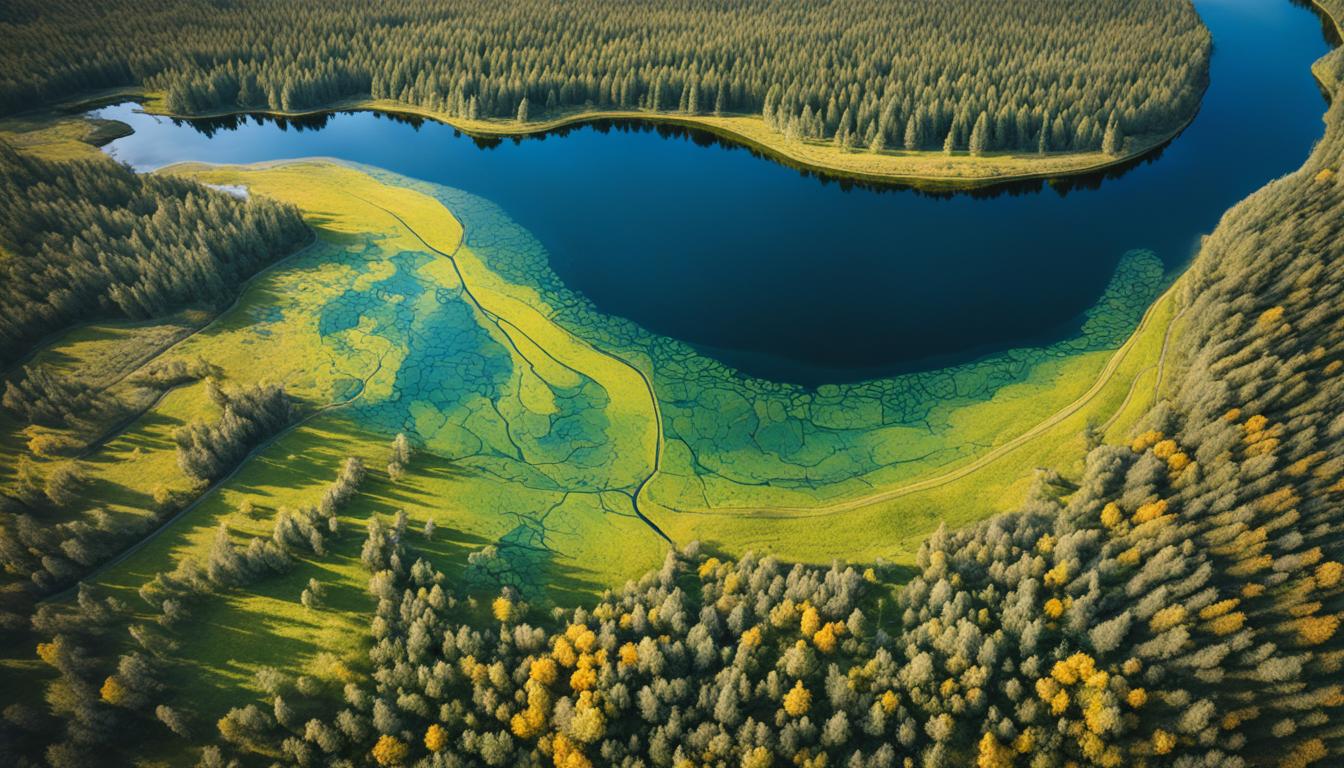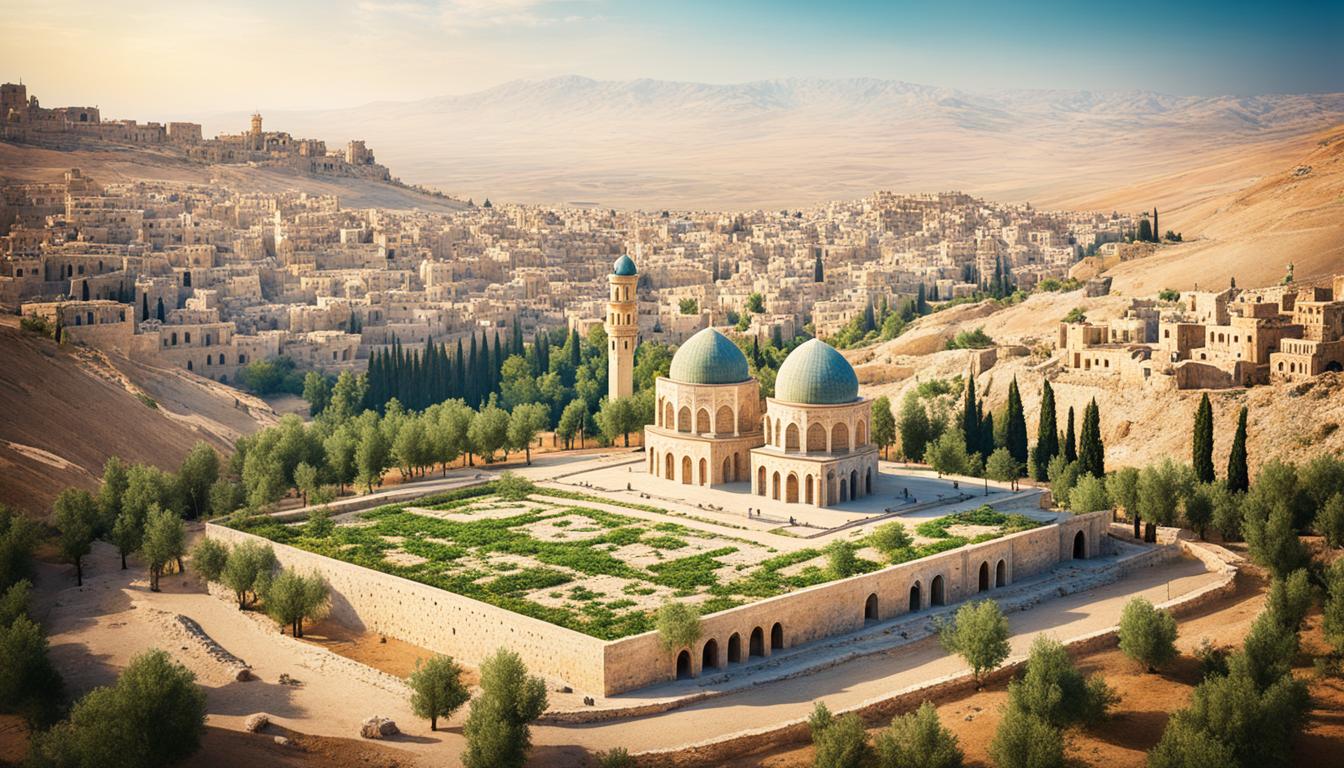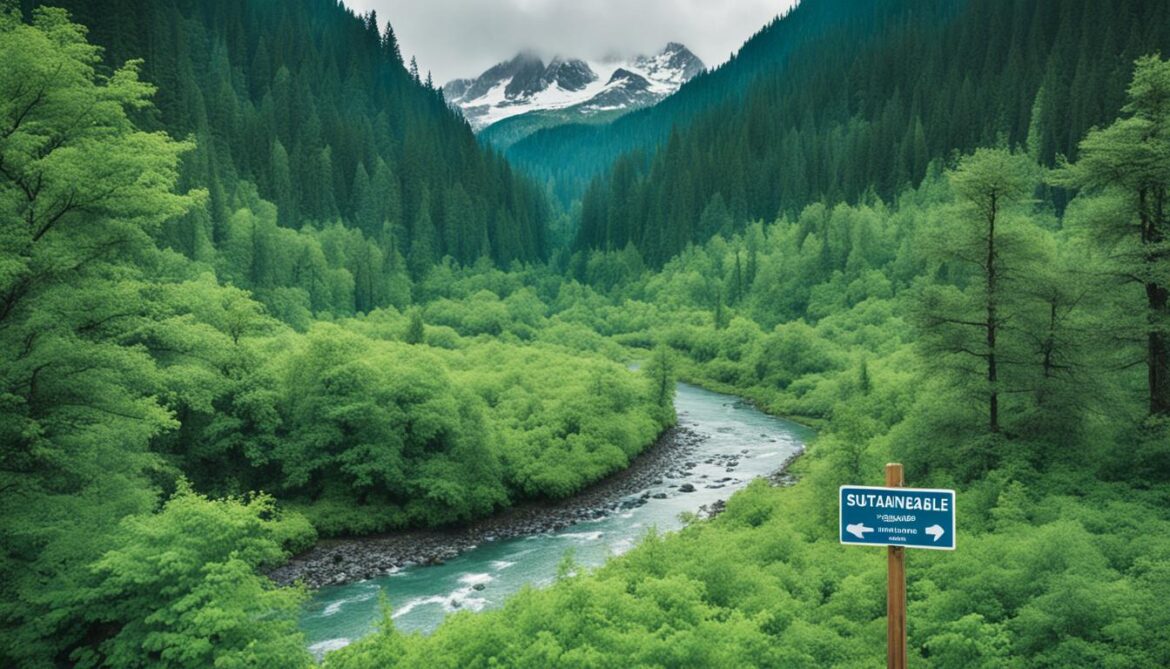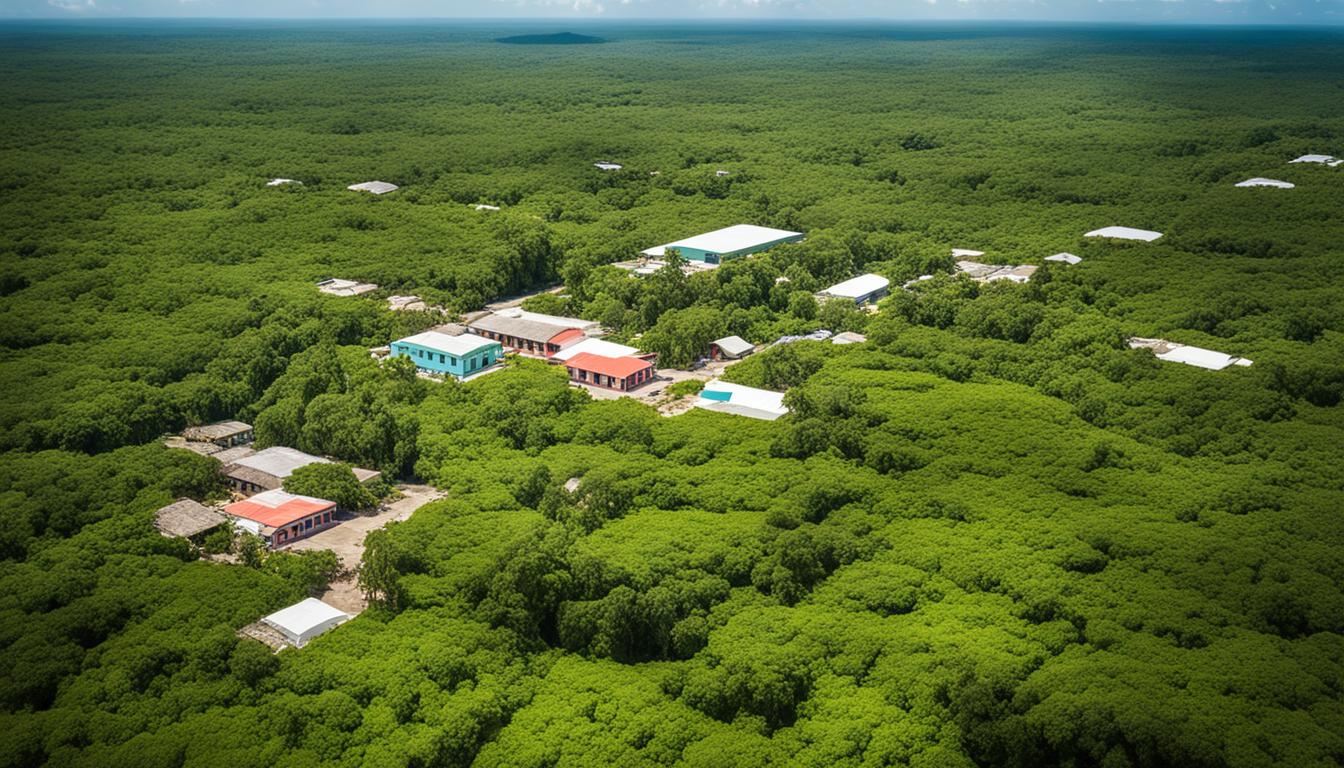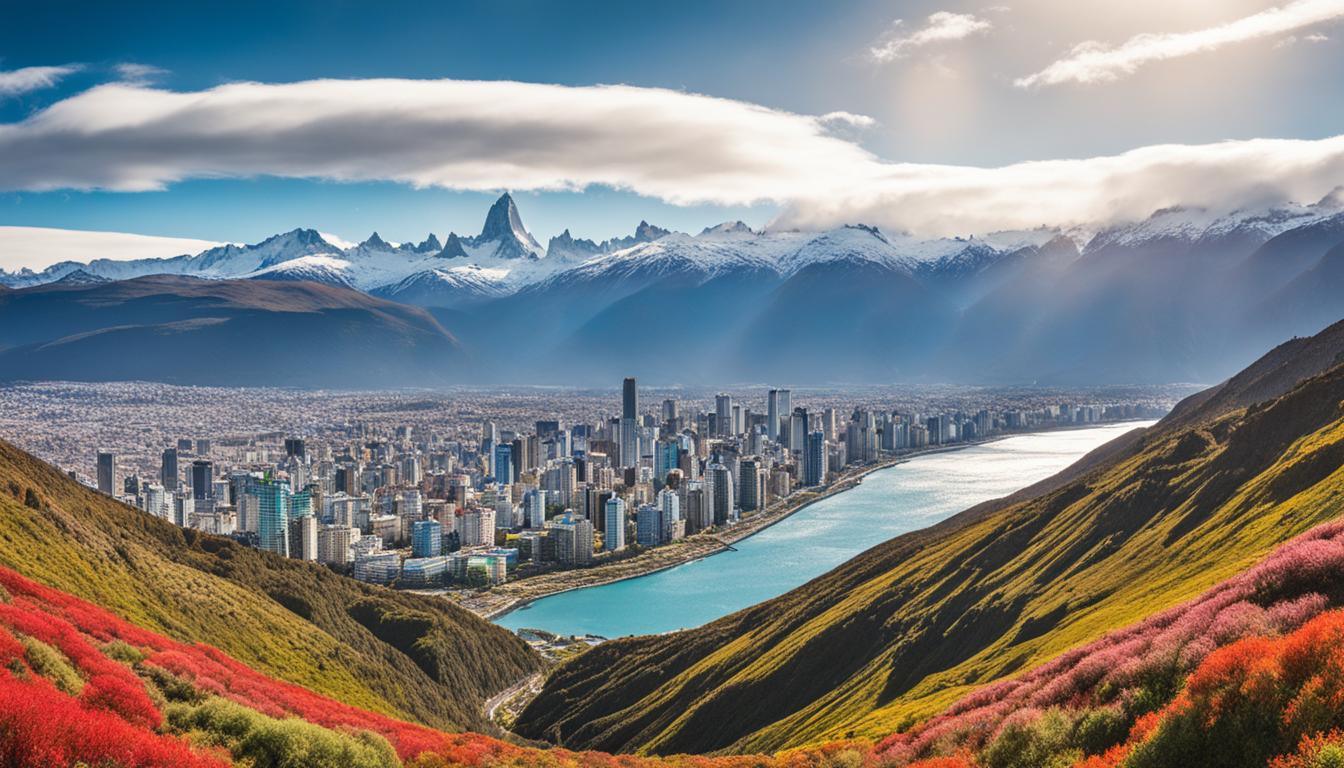Switzerland Sacred Natural Sites and Biodiversity
Did you know that sacred natural sites (SNS) have been recognized as the oldest form of habitat protection in human history? These sites have a remarkable impact on biodiversity conservation, spanning continents and geographical settings. However, research on SNS has predominantly focused on Asia and Africa, with a primary emphasis on plant life. To fill the geographical and taxonomical gaps, more systematic research is required.
Key Takeaways:
- Sacred natural sites are the oldest form of habitat protection in human history.
- These sites have a positive effect on biodiversity conservation.
- Current research primarily focuses on Asia and Africa, with limited emphasis on plant life.
- Further systematic research is needed to fill geographical and taxonomical gaps.
- Understanding the impact of sacred natural sites is crucial for effective biodiversity conservation.
The Importance of Sacred Natural Sites
Sacred natural sites have a significant impact on the conservation of Switzerland’s biodiversity. These sites, also known as Swiss sacred sites, are considered crucial areas for protecting habitats and preserving natural resources. Moreover, they play a vital role in maintaining the overall ecological diversity of the country.
Preserving Habitats and Natural Resources
Swiss sacred sites serve as sanctuaries for a wide range of plant and animal species, providing them with undisturbed habitats and essential resources for survival. The protected areas within these sites ensure the preservation of diverse ecosystems, including forests, wetlands, mountains, and meadows.
These sites also safeguard natural resources such as water bodies, mineral deposits, and medicinal plants, which are of immense value to both the environment and local communities. Their conservation contributes to the sustainable use of these resources and prevents their depletion.
Enhancing Ecological Diversity
By preserving Swiss sacred sites, nature conservation in Switzerland becomes more effective and comprehensive. These sites act as hotspots of biodiversity, promoting the presence of numerous plant and animal species and fostering ecological interactions.
The protection of diverse habitats and ecosystems within sacred sites ensures the survival of both common and rare species, including endangered and endemic ones. It also encourages the proliferation of natural processes, such as seed dispersal and pollination, that are crucial for the health and resilience of ecosystems.
Contributing to Sustainable Development
Nature conservation in Switzerland goes hand in hand with sustainable development, and Swiss sacred sites play a vital role in achieving this balance. These sites provide opportunities for tourism, research, and environmental education, contributing to the promotion of sustainable practices and the generation of local livelihoods.
Cathy Johnson, a renowned environmentalist, emphasizes the importance of Swiss sacred sites by saying, “Preserving these sacred sites not only ensures the protection of biodiversity but also honors the cultural and spiritual significance attached to these locations. It is a holistic approach towards conservation and stewardship.”
The preservation of Swiss sacred sites is an essential aspect of nature conservation in Switzerland, integrating ecological, cultural, and spiritual dimensions. By recognizing and protecting these sites, we can create a sustainable future for generations to come.
In Summary
Swiss sacred sites are of great importance to the conservation of Switzerland’s biodiversity. They play a crucial role in preserving habitats, protecting natural resources, enhancing ecological diversity, and promoting sustainable development. By valuing and safeguarding these sites, we can ensure the long-term resilience of both natural and cultural heritage in Switzerland.
The Role of Sacred Natural Sites in Biodiversity Conservation
Sacred natural sites play a crucial role in the protection and conservation of biodiversity in Switzerland. These sites have been shown to have positive effects on taxonomical diversity, vegetation structure, and cultural uses of biodiversity. They act as refugia for endemic and threatened species, providing a safe haven for their survival. Additionally, sacred natural sites preserve old-growth trees and forest patches, contributing to the overall ecological diversity of Switzerland.
These sites serve as important habitats for a wide range of flora and fauna, supporting the interconnectedness and balance of ecosystems. The cultural significance attached to these sites also strengthens the local communities’ commitment to their preservation.
By safeguarding sacred natural sites, we can ensure the continued protection of biodiversity and the unique ecological heritage of Switzerland. Furthermore, by recognizing the value of these sites and integrating their conservation into land-use planning and management strategies, we can promote sustainable practices and contribute to the long-term ecological health of our natural landscapes.
“Sacred natural sites act as refugia for endemic and threatened species, providing a safe haven for their survival.”
The Positive Effects of Sacred Natural Sites
The positive effects of sacred natural sites extend beyond their role as refugia. These sites also contribute to the preservation of vegetation structure, enhancing ecological stability and resilience. The presence of old-growth trees and forest patches within sacred natural sites provides habitats for a diverse range of species, supporting the intricate web of life.
Furthermore, sacred natural sites uphold cultural practices that promote sustainable uses of biodiversity. The cultural significance attached to these sites fosters a sense of respect and reverence for nature, encouraging responsible stewardship and conservation efforts.
Preserving Switzerland’s Ecological Diversity
Switzerland is known for its remarkable ecological diversity, characterized by a variety of ecosystems, habitats, and species. The preservation and conservation of sacred natural sites play a vital role in maintaining this rich biodiversity, ensuring the long-term health and viability of our natural environments.
Through the protection of these sites, we can safeguard endemic species and unique genetic resources, enriching the overall biodiversity of Switzerland. The integration of conservation practices and sustainable land management strategies in and around these sites can also enhance the connectivity and resilience of ecosystems, allowing for the successful adaptation to environmental changes.
| Biodiversity Protection | Swiss Ecological Diversity |
|---|---|
| Preservation of endemic and threatened species | Enhancement of vegetation structure |
| Conservation of old-growth trees and forest patches | Contribution to overall ecological diversity |
| Promotion of sustainable uses of biodiversity | Integration of cultural practices in conservation |
Geographic Regions and Climate of Liechtenstein
Liechtenstein, located between Switzerland and Austria, boasts a diverse geography that encompasses various unique landscapes. Divided into three distinct regions – the Rhine Valley plain, Rhine Valley slopes, and mountain region – Liechtenstein offers a range of breathtaking views and natural wonders.
The Rhine Valley plain, situated in the western part of the country, features lush meadows and fertile agricultural land. This region benefits from its proximity to the Rhine River, which provides fertile soils and supports diverse flora and fauna. The gentle slopes and expansive plains offer opportunities for leisure activities and provide a habitat for various species.
The Rhine Valley slopes, located to the east of the plain, present a slightly different landscape with its rolling hills and vineyards. This region is known for its picturesque scenery, characterized by terraced vineyards, quaint villages, and charming castles. The scenic beauty of the slopes attracts visitors and provides valuable ecological habitat for both plant and animal species.
The mountain region, comprising the eastern part of Liechtenstein, showcases the country’s alpine landscapes. Majestic peaks, including the iconic Grauspitz, dominate the skyline and offer breathtaking views. The mountains are home to a diverse range of alpine flora and fauna, including rare and endemic species that have adapted to the challenging high-altitude conditions.
The climate in Liechtenstein is influenced by its transition zone location, where oceanic and continental climates converge. The country experiences relatively mild summers and cold winters. Its unique climate positioned between the lowlands and mountains creates favorable conditions for a rich variety of habitats and species.
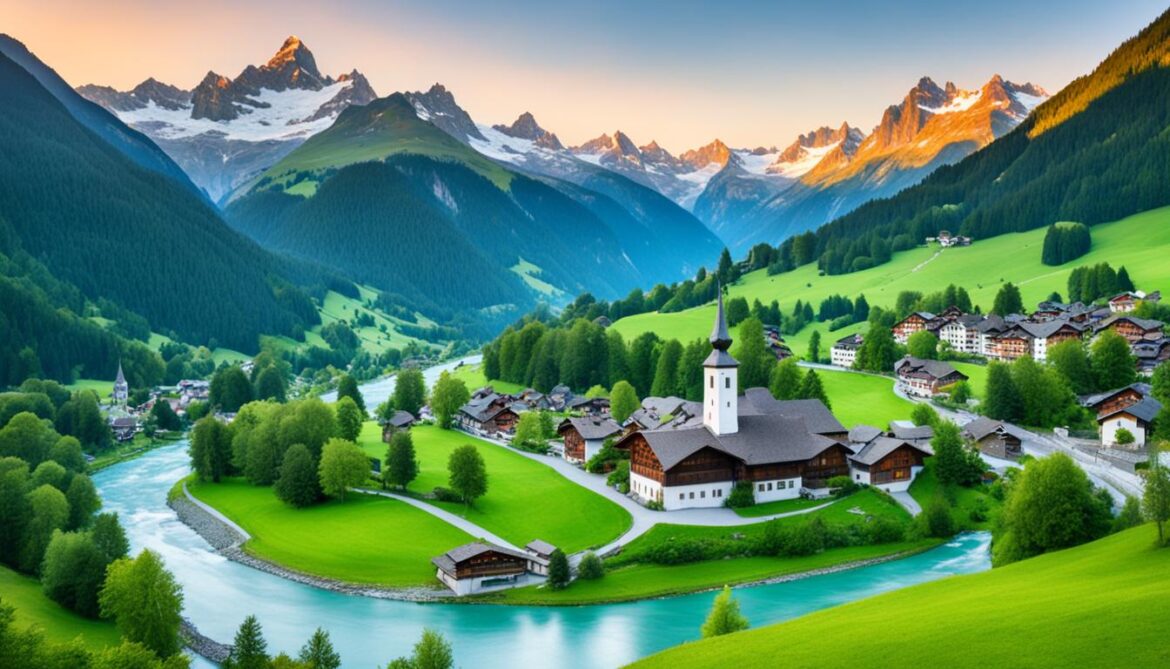
Liechtenstein’s Climate Zones
| Region | Climate |
|---|---|
| Rhine Valley plain | Moderate continental |
| Rhine Valley slopes | Semi-continental |
| Mountain region | Alpine |
The climate zones within Liechtenstein offer an array of unique environments, each supporting its own distinct ecosystem. From the fertile plains to the scenic slopes and the challenging yet rewarding alpine heights, Liechtenstein’s sacred landscapes provide a diverse range of habitats for numerous species. These natural wonders truly showcase the beauty and ecological significance of sacred landscapes in Switzerland.
Acknowledging and preserving these landscapes is crucial to ensure their protection for future generations and to maintain the delicate balance of nature in Liechtenstein.
Biodiversity in Liechtenstein
Liechtenstein is renowned for its rich biodiversity, boasting a diverse range of flora and fauna. The country’s unique landscapes and favorable climate provide ideal habitats for a variety of species, contributing to its vibrant ecological tapestry.
Flora of Liechtenstein
The flora of Liechtenstein showcases a wide array of plant species, including breathtaking alpine wildflowers, majestic deciduous trees, and towering coniferous forests. These diverse habitats support a thriving ecosystem, nurturing various plant species and providing a lush green backdrop to the country’s scenic landscapes.
Fauna of Liechtenstein
The fauna of Liechtenstein is equally remarkable, encompassing a vast range of mammals, avian species, reptiles, amphibians, and insects. From the majestic red deer roaming the forests to the graceful golden eagle soaring through the skies, Liechtenstein’s fauna captivates nature enthusiasts and offers endless opportunities for wildlife observation.
To ensure the preservation of Liechtenstein’s unique biodiversity, the country maintains comprehensive red lists. These lists not only aid in identifying and cataloging threatened species but also serve as a valuable tool for conservation efforts and provide a roadmap for focused preservation actions.
“Liechtenstein’s biodiversity is a testament to the harmonious coexistence between nature and human civilization. It is our duty to protect and preserve these invaluable ecosystems for future generations.” – Environmental Conservation Society of Liechtenstein
By safeguarding the diverse flora and fauna of Liechtenstein, the country is upholding its commitment to environmental conservation and biodiversity preservation in Switzerland.
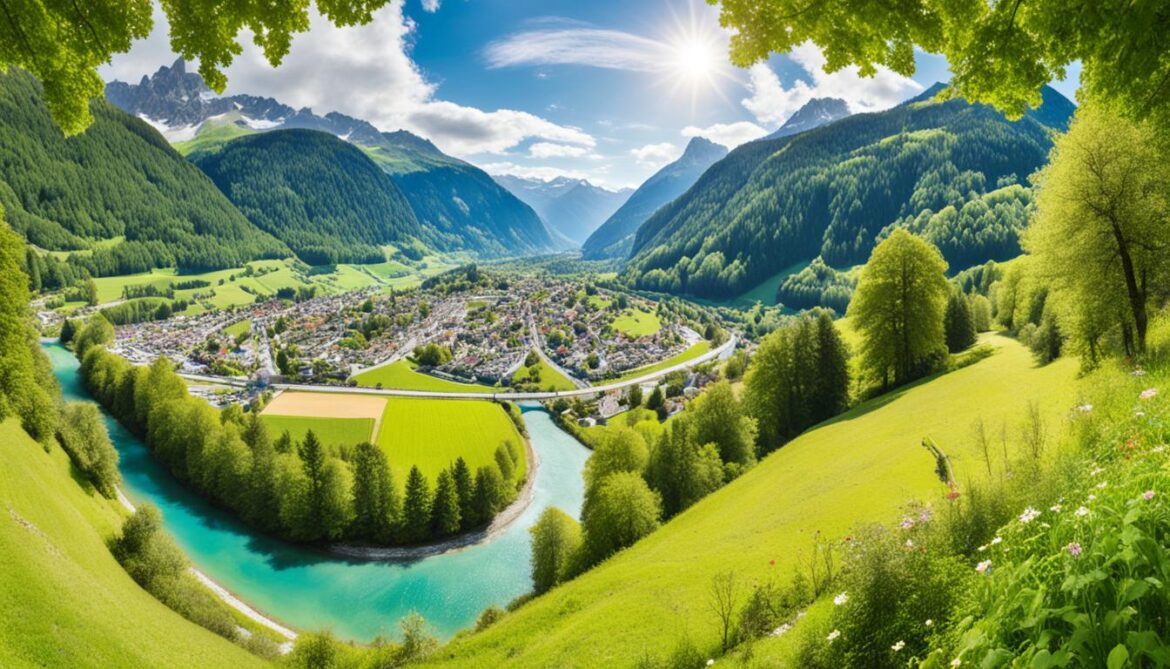
| Category | Examples |
|---|---|
| Mammals | Red deer, Alpine ibex, Brown hare |
| Avian Species | Golden eagle, Eurasian blackbird, Great spotted woodpecker |
| Reptiles | Adder, European pond turtle, Grass snake |
| Amphibians | Common toad, Alpine newt, European tree frog |
| Insects | Butterflies, Bees, Dragonflies |
| Flora | Alpine wildflowers, Deciduous trees, Coniferous forests |
Protection Areas in Liechtenstein
Liechtenstein, a country renowned for its commitment to environmental conservation and biodiversity preservation, has established a network of diverse protection areas. These areas, including nature protection, forest protection, plant protection, and landscape protection areas, serve as crucial safeguards for the country’s natural heritage.
The protected areas in Liechtenstein play a critical role in maintaining and enhancing the country’s ecological balance. By preserving and managing these areas, Liechtenstein ensures the long-term viability of habitats, promotes the conservation of endangered species, and protects the scenic beauty and cultural landscapes that are part of its rich heritage.
Protected areas, such as conservation areas and nature reserves, are carefully selected to encompass a wide range of ecosystems, ensuring the preservation of diverse flora and fauna. These areas serve as sanctuaries for numerous species, providing them with safe havens and supporting their survival.
Moreover, the protected areas in Liechtenstein not only conserve valuable natural resources but also offer unparalleled opportunities for education and recreation. Visitors can immerse themselves in the beauty of unspoiled landscapes, reconnect with nature, and learn about the importance of biodiversity conservation.
Protection areas in Liechtenstein are a testament to the country’s commitment to environmental stewardship and sustainable preservation. By preserving these invaluable natural spaces, Liechtenstein ensures that future generations can continue to enjoy the wonders and benefits of a diverse and thriving ecosystem.
To illustrate the breadth and significance of Liechtenstein’s protection areas, the following table provides an overview of the various categories and their respective features:
| Category | Features |
|---|---|
| Nature Protection Areas | Permanently protected areas designated for the conservation of ecologically valuable habitats. |
| Forest Protection Areas | Protected forests managed for biodiversity conservation and sustainable timber production. |
| Plant Protection Areas | Designated areas focused on the preservation and propagation of rare and threatened plant species. |
| Landscape Protection Areas | Diverse landscapes preserved for their visual beauty, cultural significance, and ecological functions. |
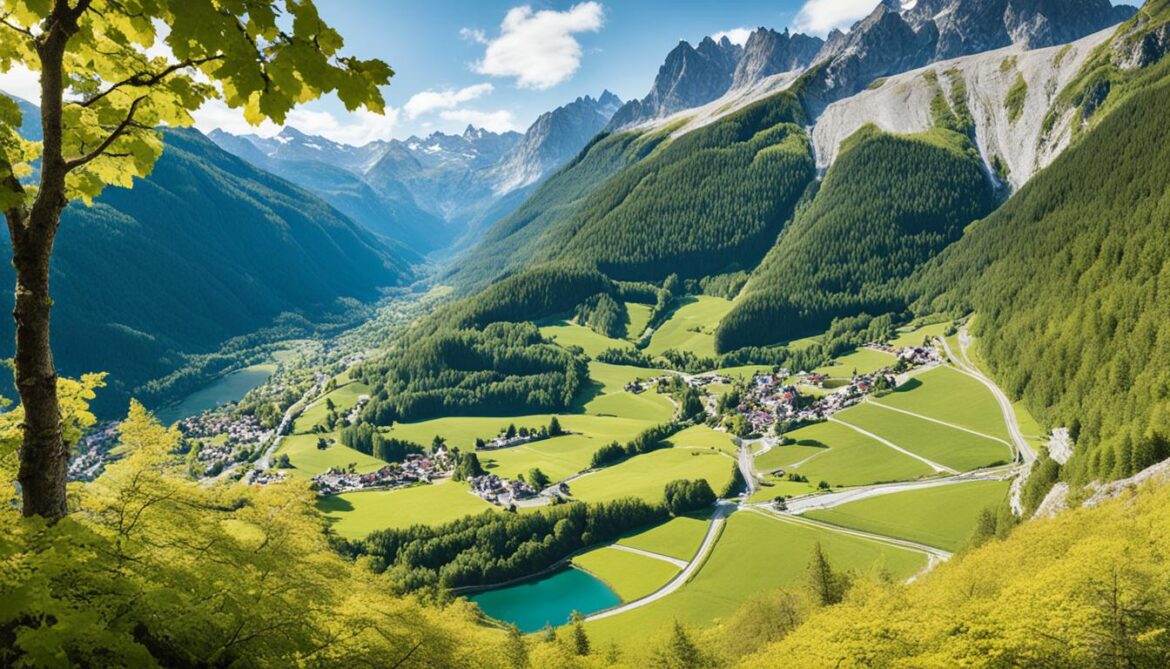
Preserving Biodiversity for Future Generations
The establishment and management of protection areas in Liechtenstein demonstrate the country’s commitment to sustainable development and biodiversity conservation. These areas serve as vital strongholds for protecting endangered species, habitats, and ecosystems. Through continued efforts to maintain and expand these protection areas, Liechtenstein aims to secure a resilient and thriving natural environment for present and future generations.
Importance of Protection Areas for Biodiversity Conservation
The protection areas in Liechtenstein play a crucial role in the conservation of the country’s unique biodiversity. These areas ensure the long-term ecological sustainability of landscapes and habitats, supporting the preservation of threatened species and natural resources.
Environmental stewardship is at the heart of the effort to protect these vital areas. Through sustainable preservation practices, we can maintain the delicate balance of ecosystems and safeguard the rich biodiversity that Liechtenstein offers. By actively managing and maintaining these protection areas, we can create a harmonious coexistence between human activities and the natural environment.
“Conservation is a state of harmony between men and land.” – Aldo Leopold
Sustainable preservation involves the responsible use of resources, the protection of vulnerable species, and the restoration of degraded habitats. By implementing conservation strategies that are both environmentally friendly and economically viable, we can ensure the long-term viability of our natural heritage.
Environmental Stewardship
Environmental stewardship is a commitment to the responsible and sustainable management of natural resources. It involves understanding the ecological value of protection areas and taking proactive measures to preserve their integrity.
Through effective environmental stewardship, we can minimize the negative impacts of human activities on ecosystems while maximizing the benefits of biodiversity conservation. This includes adopting practices such as habitat restoration, wildlife monitoring, and sustainable land management.
The preservation of protection areas requires the collaboration of various stakeholders, including government agencies, local communities, and conservation organizations. By working together, we can ensure the effective implementation of environmental stewardship practices and the long-term maintenance of these critical habitats.
Sustainable Preservation
Sustainable preservation aims to protect and conserve natural resources while meeting the needs of present and future generations. It involves finding a balance between human development and environmental conservation.
By adopting sustainable preservation practices, we can minimize the ecological footprint of human activities and promote the resilience of ecosystems. This includes promoting sustainable agriculture, reducing waste and pollution, and implementing renewable energy sources.
It is essential to recognize the interconnectedness of environmental, social, and economic factors in sustainable preservation. By considering these interdependencies, we can ensure the long-term viability of protection areas and promote a more sustainable future.
The image above highlights the importance of sustainable preservation and environmental stewardship in safeguarding our natural heritage. The beauty and diversity of Liechtenstein’s protection areas are a testament to the successful conservation efforts that have been implemented.
As we continue to face environmental challenges, it is crucial to prioritize the preservation of protection areas. By embracing environmental stewardship and sustainable practices, we can protect the biodiversity that makes Liechtenstein so unique, ensuring a sustainable future for generations to come.
Threats to Biodiversity in Liechtenstein
Liechtenstein faces several environmental threats and conservation challenges that pose significant risks to its biodiversity and ecosystems. These threats jeopardize the delicate balance of the natural environment and put vulnerable plant and animal species at risk of extinction.
Habitat Loss and Abandonment of Agricultural Land
One of the major threats to biodiversity in Liechtenstein is the abandonment of agricultural land. As the agricultural industry experiences changes and shifts, many farmers have discontinued farming practices, leading to the loss of valuable habitats for various species. This abandonment results in a decline in biodiversity and disrupts the natural balance of ecosystems.
Infrastructure Development and Urban Sprawl
The rapid development of infrastructure and urban areas in Liechtenstein poses a significant threat to biodiversity. The expansion of roads, buildings, and industrial areas leads to habitat fragmentation, which isolates populations and restricts their ability to move and interact. Urban sprawl also leads to the destruction of natural habitats, displacing wildlife and reducing their chances of survival.
Intensification of Agriculture
The intensification of agriculture, including the increased use of chemical fertilizers and pesticides, has detrimental effects on biodiversity in Liechtenstein. These practices can contaminate soil and water, leading to the degradation of ecosystems and the loss of habitat for plant and animal species. Additionally, the conversion of natural habitats into agricultural land further exacerbates the loss of biodiversity.
Climate Change
Climate change presents a significant challenge to the preservation of biodiversity in Liechtenstein. Rising temperatures, changing precipitation patterns, and extreme weather events can disrupt ecosystems and negatively impact the survival of sensitive species. Changes in temperature and rainfall may lead to the decline or loss of habitats, reducing the availability of resources for plant and animal species.
Conservation Challenges
Addressing these environmental threats and conservation challenges requires concerted efforts and effective strategies to protect and restore biodiversity in Liechtenstein. It is crucial to promote sustainable land-use practices, prioritize habitat conservation, and mitigate the impacts of climate change. Collaborative initiatives involving government agencies, conservation organizations, and local communities can play a vital role in conserving the country’s unique natural heritage.
“The conservation of biodiversity is not just a task for scientists and policymakers but also requires the active engagement and participation of local communities and individuals. Together, we can work towards a sustainable future for Liechtenstein’s precious natural resources.”
| Threats | Consequences |
|---|---|
| Habitat Loss and Abandonment of Agricultural Land | Loss of valuable habitats and biodiversity decline |
| Infrastructure Development and Urban Sprawl | Habitat fragmentation and displacement of wildlife |
| Intensification of Agriculture | Contamination of soil and water, loss of natural habitats |
| Climate Change | Disruption of ecosystems, loss of habitats |
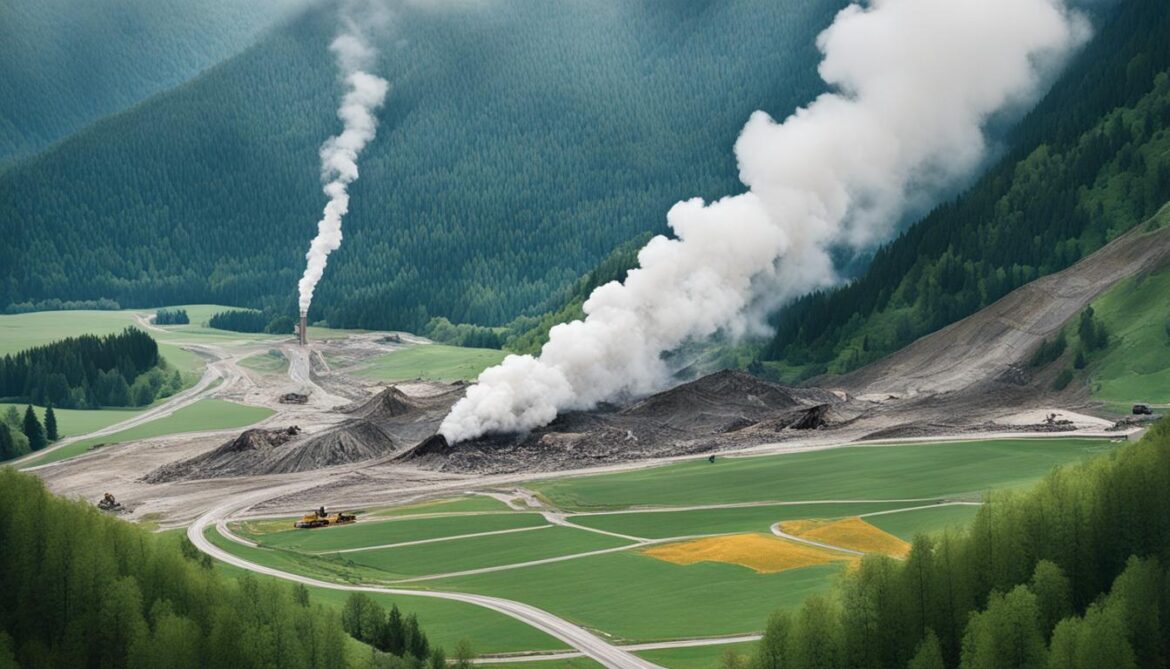
Efforts to address these threats and challenges play a vital role in safeguarding Liechtenstein’s biodiversity for future generations. By raising awareness, implementing conservation measures, and fostering sustainable practices, we can protect the rich natural heritage that makes Liechtenstein so special.
Measures to Address Biodiversity Threats in Liechtenstein
Liechtenstein is committed to preserving its rich biodiversity through a range of comprehensive conservation efforts and sustainability initiatives. These measures are designed to mitigate threats and ensure the long-term protection of the country’s unique wildlife and ecosystems.
Sustainable Land Management Practices
One of the key strategies employed by Liechtenstein is the implementation of sustainable land management practices. This involves the careful planning and utilization of land resources to minimize environmental impacts and preserve biodiversity. By promoting sustainable forestry practices, responsible agriculture, and efficient land use, Liechtenstein aims to maintain a balance between human development and nature conservation.
Prohibition of Pesticide and Fertilizer Use in Forests
In order to safeguard the health and diversity of forest ecosystems, Liechtenstein has enacted a strict prohibition on the use of pesticides and fertilizers in its forests. This sustainable approach helps maintain the natural balance of flora and fauna, ensuring the well-being of biodiversity at all levels. It also protects the quality of water sources and other critical habitats within forested areas.
“By prohibiting the use of pesticides and fertilizers in our forests, we are taking a proactive stance in preserving the delicate ecosystems that support our biodiversity. This ensures that future generations can continue to enjoy the wonders of our natural landscapes.” – Hans Müller, Environmental Conservation Officer
Promotion of Sustainable Practices in Agriculture and Infrastructure Development
Liechtenstein recognizes the importance of sustainable practices in both agriculture and infrastructure development. Through the promotion of organic farming methods, responsible land use planning, and the integration of green technologies, the country aims to reduce the negative impact of these activities on biodiversity. By adopting sustainable approaches in these sectors, Liechtenstein is able to meet its development needs while prioritizing environmental conservation.
Advancing Long-Term Sustainability
Liechtenstein’s conservation efforts and sustainability initiatives are driven by a commitment to long-term sustainability. The country understands that protecting biodiversity is not a short-term goal but a continuous process that requires ongoing dedication and collaboration. By actively engaging stakeholders, raising awareness, and implementing innovative solutions, Liechtenstein aims to create a sustainable future for its unique ecosystems and the species that depend on them.
Efforts in Action: Conservation Initiatives in Liechtenstein
Table: Key Conservation Initiatives in Liechtenstein
| Initiative | Description |
|---|---|
| Protected Area Expansion | Increasing the size and number of protected areas to preserve critical habitats and biodiversity hotspots. |
| Species Recovery Programs | Implementing targeted programs to recover endangered species and restore their populations. |
| Education and Awareness Campaigns | Creating educational initiatives and awareness campaigns to foster a culture of environmental stewardship. |
| Green Infrastructure Development | Integrating green infrastructure into urban planning to enhance biodiversity and promote ecological connectivity. |
These initiatives provide a glimpse into the proactive measures being taken by Liechtenstein to confront biodiversity threats and ensure the well-being of its natural heritage. By combining scientific research, sustainable practices, and community engagement, Liechtenstein is setting an example for other nations in the pursuit of ecological balance and long-term sustainability.
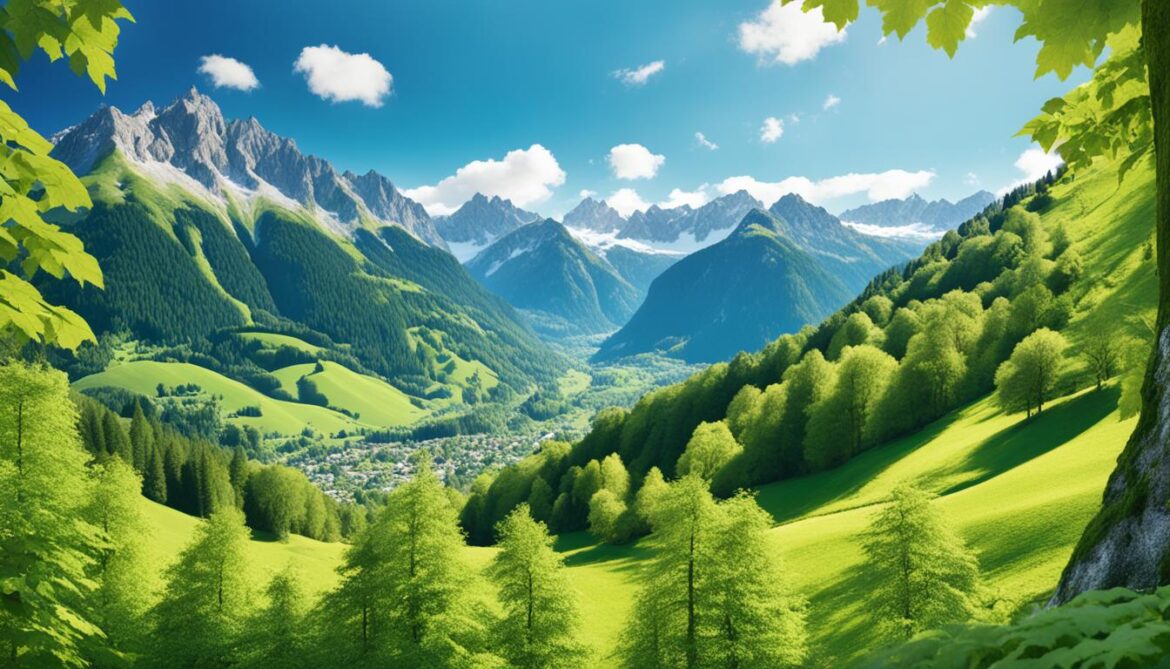
Initiatives for Natural Places of Religious Interest
Liechtenstein actively supports and monitors local practices and initiatives related to natural places of religious interest. These initiatives aim to preserve the cultural and spiritual significance of these sites and promote their conservation for future generations.
One of the key initiatives is the mapping of sacred sites. By identifying and documenting these sites, valuable information is gathered about their ecological, cultural, and historical importance. This mapping process allows for better management and protection of these areas, ensuring their long-term sustainability.
Furthermore, Liechtenstein is committed to preserving the rituals and traditions associated with these natural places. These practices are an integral part of the cultural heritage of the local communities and contribute to the overall richness and diversity of the country. By safeguarding and promoting these rituals and traditions, Liechtenstein ensures the continuity of the spiritual connection between the community and the natural environment.
Community participation plays a vital role in the conservation efforts of these natural places of religious interest. The active involvement of local communities ensures that conservation initiatives are tailored to the specific needs and aspirations of the people who live in and around these sites. This participatory approach fosters a sense of ownership and responsibility, empowering the community to actively contribute to the preservation and sustainable management of these important areas.
“The involvement of local communities in the conservation of natural places of religious interest is crucial. It strengthens the bond between people and nature, promoting a sense of stewardship and ensuring the long-term protection of these sacred sites.”
Sustainable Tourism and Education
In addition to conservation efforts, Liechtenstein recognizes the importance of sustainable tourism and education in promoting the understanding and appreciation of natural places of religious interest. Sustainable tourism practices ensure that visitor activities do not compromise the ecological integrity of these sites and respect the cultural values associated with them.
Education plays a crucial role in raising awareness about the ecological, cultural, and spiritual values of these natural places. Liechtenstein actively promotes educational programs that highlight the significance of these sites and encourage responsible behavior among visitors. By fostering a deep understanding and appreciation for these natural places, future generations will be inspired to continue the legacy of conservation and community participation.
Partnerships and Collaboration
Liechtenstein recognizes that protecting natural places of religious interest requires collaborative efforts. The country actively seeks partnerships with local and international organizations, government agencies, and academic institutions to strengthen conservation initiatives and share knowledge and best practices.
Through these partnerships, Liechtenstein aims to enhance the effectiveness of conservation measures, support research and monitoring efforts, and foster international cooperation in the preservation of these unique and sacred sites.

| Benefits of Local Practices and Community Participation |
|---|
| 1. Enhanced ecological knowledge and understanding |
| 2. Improved conservation outreach and education |
| 3. Increased social cohesion and community empowerment |
| 4. Sustainable management and stewardship of natural places |
| 5. Preservation of cultural and spiritual heritage |
Conclusion
Liechtenstein and Switzerland both boast diverse and unique sacred natural sites that play a crucial role in biodiversity conservation. These sites contribute significantly to the overall ecological diversity and provide essential habitats for various species. However, the conservation of these valuable natural resources faces significant challenges due to habitat loss, climate change, and human activities.
Addressing these threats requires sustainable preservation and conservation efforts, as well as active community involvement. By implementing sustainable land management practices, promoting the prohibition of harmful chemicals in forests, and supporting sustainable practices in agriculture and infrastructure development, Liechtenstein and Switzerland can ensure the long-term protection of their biodiversity.
It is crucial that we recognize the cultural and spiritual significance of these sacred sites and work together to preserve them for future generations. By prioritizing the conservation of these unique natural treasures, we can safeguard their ecological and cultural value, promote environmental stewardship, and contribute to a sustainable future for all.
Key Takeaways: Liechtenstein and Switzerland’s sacred natural sites are important for biodiversity conservation. Threats such as habitat loss, climate change, and human activities pose challenges to these invaluable resources. Sustainable preservation, conservation efforts, and community involvement are crucial for ensuring the long-term protection of these sacred sites and their contribution to ecological diversity.




